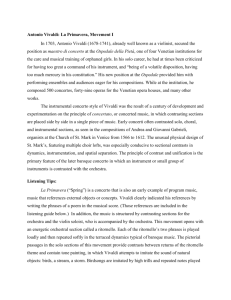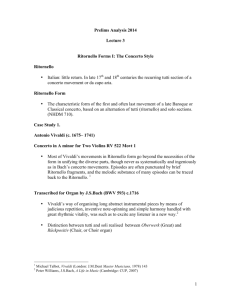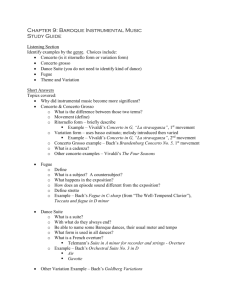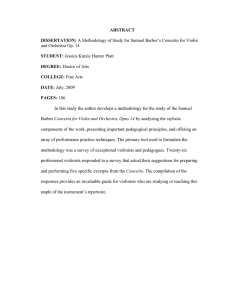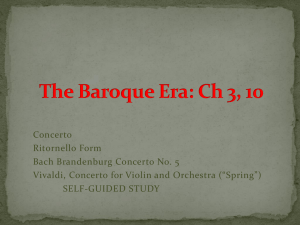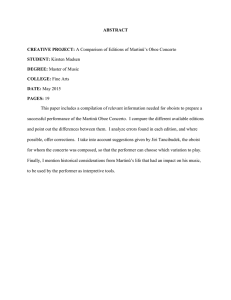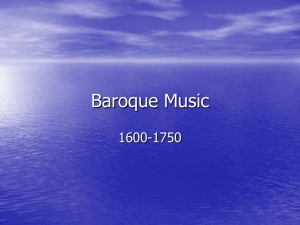Chapter 9 Baroque Instrumental Music Concerto and
advertisement
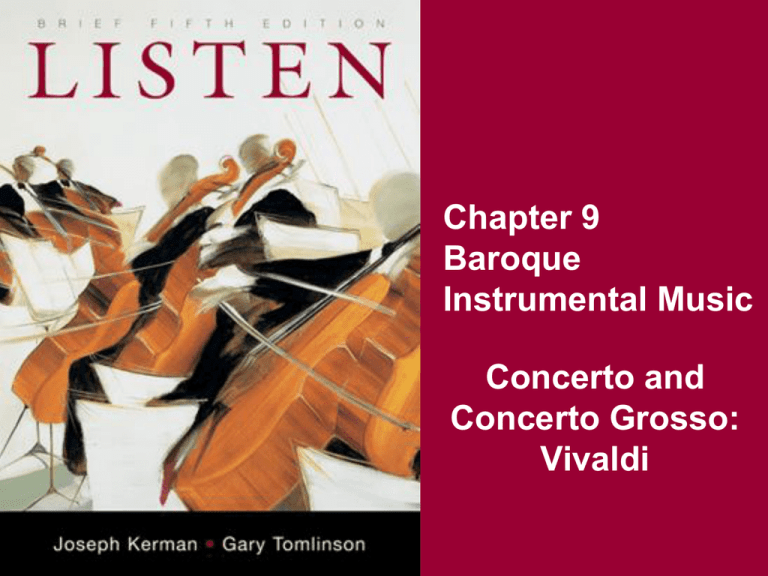
Chapter 9 Baroque Instrumental Music Concerto and Concerto Grosso: Vivaldi Key Terms Concerto Concerto grosso Concertare Movement Ritornello form Ritornello Archlute Variation form Basso continuo Chaconne Passacaglia Ground Ground bass Double listening Baroque Instrumental Music (1) For the first time, listeners & musicians took instrumental music seriously Rise of instrumental music paralleled improvements in instrument-building • Stradivarius, Silbermann, etc. How long should a piece be? • With vocal music, when the words are done • With instrumental music, no equivalent guide • Instrumental forms & genres had to provide guidelines Baroque Instrumental Music (2) How to extend purely instrumental music in time in a logical manner? • Repetition, return, sequence, & imitation • Begin & end in the same key How to create interest and drama? • Contrast & variation • Modulate to other keys in the middle • String contrasting movements together Baroque forms and genres combine these techniques in various ways Concerto and Concerto Grosso The most important orchestral genres of the Baroque era Latin concertare = to contend Concerto signifies a contest between— • Soloist & orchestra (concerto) • Group of soloists & orchestra (concerto grosso) • Virtuoso brilliance of solos & orchestra’s power, stability Movements Movement = self-contained section of a larger work Many Baroque works create drama & length by stringing together several short, contrasting pieces (movements) A typical concerto has three movements • I – bright, extroverted, in a fast tempo • II – slower, quieter, more emotional • III – similar to 1st movement, often faster Ritornello Form (1) Commonly used in 1st & 3rd movements of Baroque concerto Italian ritorno = return (home) Ritornello form is based on systematic use of contrast & return Consistent alternation between two contrasting sections— • Ritornellos & solo episodes Return of theme more satisfying after contrasting solos (sense of resolution) Ritornello Form (2) Standard ritornello form RIT = complete ritornello statement [RIT] = partial ritornello statement Solo 1, 2, 3, etc. = solo episodes Ritornello vs. Episode Ritornello Principal theme Solid & forceful Often very tuneful For full orchestra Stable–stays in one key, ends with strong cadence Familiarity grows with each return Solo Episode Contrasting section Faster, more brilliant Free & virtuosic For soloist(s) Unstable–modulates to another key, flows into next ritornello Always something new, surprising Antonio Vivaldi (1678-1741) Famous as violinist & composer Most popular Baroque concerto composer • Four Seasons his most popular work Wrote over 500 concertos The “Red Priest” was also music teacher at a Venetian orphanage • Renowned for quality of musical training • Famous for student concerts Frequent travel to perform his concertos & operas in musical centers of Europe Vivaldi, Violin Concerto in G Vivaldi concertos often published in sets of 6 or 12 • Sets often given descriptive titles— La stravaganza (Extravagance), Four Seasons, or L’estro armonico (Harmonic Whims) Op. 4, No. 12 is the last concerto in his fourth published set (Latin opus = work) Concerto for solo violin & orchestra Uses standard three-movement format • I & III fast, brilliant, ritornello form • II slower, gentler, ground bass form Vivaldi, Violin Concerto in G, I (1) Tempo “Spirited, not too fast” Creative use of ritornello form Ritornello theme (for orchestra) • Subdivides into three short sections–a, b, c • Alternates between 1st & 2nd violin sections Vivaldi, Violin Concerto in G, I (2) Ritornello theme (cont.) • • • • Only Ritornello 1 uses entire theme Ritornellos 1, 2, & 5 in G major Ritornello 3 begins in D major; 4 in B minor Surprisingly free use of theme in Ritornellos 3 and 4 Vivaldi, Violin Concerto in G, I (3) Solo episodes • Feature solo violin, usually with continuo accompaniment • Solos become progressively freer & more virtuosic Ritornellos & solos swap roles at times! • Ritornello 4 modulates frequently–unstable • Solo 3 affirms B minor throughout • Orchestral strings accompany Solos 2 & 4 Ends with literal return of ritornello (b, c) Baroque Variation Form Variation forms rely on repetition & contrast—simultaneously! Grew up spontaneously all over Europe; first improvised, then written out Preference for short themes: 4 to 8 bars Uninterrupted repetition of an ostinato: short melody or chord progression Names include passacaglia, chaconne, ground The Ground Bass Features of ground bass form— • Systematic, uninterrupted repetition of a short, clearly defined melody (basso ostinato) • Dynamics, tone color, & some harmonies often change with each repetition (variation) • Tempo, key, & mode are sometimes varied • Even the ground bass can be varied, but its identity is rarely obscured “Double listening”–try to hear repeating theme & changing material at same time Vivaldi, Violin Concerto in G, II (1) Slow tempo–Largo Based on 6-bar ground bass Continuous feel enhanced by— • Uninterrupted repetition of ground bass • Steady eighth-note rhythms • Dominant harmony at end of ground bass pulls to tonic at beginning of next repetition Vivaldi, Violin Concerto in G, II (2) Variety created by— • Gradually faster solo figuration in first four variations • Sudden, dramatic changes in Variations 5-6 Switch to minor mode Ostinato moves to violins Continuo drops out Vivaldi, Violin Concerto in G, II (3) To increase coherence, composers often group variations to make larger sections Vivaldi creates three sections here • Theme & Variations 1-4–Entirely in G major, basso ostinato • Variations 5-6–Shifts to G minor, ostinato moves to violins • Final statement of Theme–As at the beginning Overall ternary feel (A B A) Vivaldi, Violin Concerto in G, III Fast tempo, ritornello form Form even freer than in 1st movement • • • • Begins with solo introduction 1st ritornello statement interrupted by solo 2nd ritornello presents new theme Solo violin constantly changes from one idea to another 3rd & 5th ritornellos provide stability

